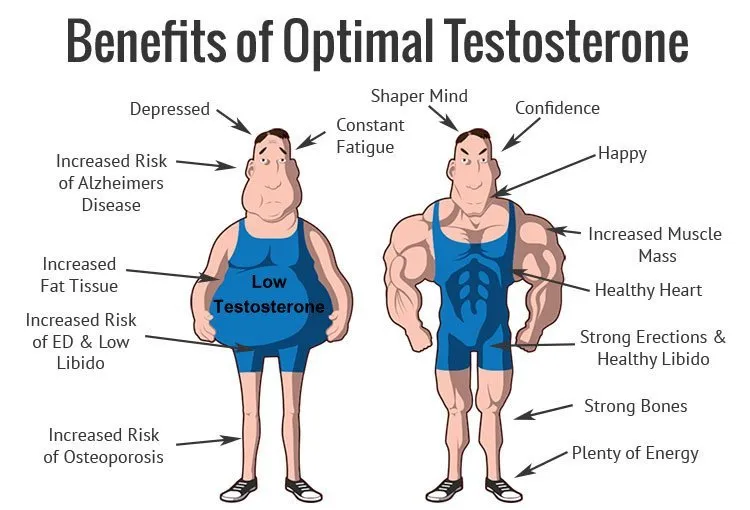
When it comes to optimizing our fitness levels, we often explore various exercises and activities that promise to boost our performance.
One such activity that has gained immense popularity is cycling. Not only does it offer an excellent cardiovascular workout, but it also helps build strength and endurance.
However, an intriguing question arises: can cycling increase testosterone levels?
In this article, we will delve into this query, examine the potential benefits, and uncover the truth behind the relationship between cycling and testosterone.
So, hop on your saddle, and let’s ride through the fascinating world of cycling and its effects on testosterone levels!
What is Testosterone?
Testosterone is a hormone primarily produced in the testes in males and in smaller amounts in the ovaries and adrenal glands in females.
It is a key hormone that plays a vital role in the development of secondary sexual characteristics and is associated with increased muscle mass, strength, and libido. Testosterone also influences mood, cognition, and overall well-being.
Can Cycling Increase Testosterone? Separating Fact from Fiction
Cycling enthusiasts often wonder if their favorite hobby has any impact on testosterone production. Let’s address this pressing question head-on.
The Science Behind Testosterone Production
Before we explore the potential effects of cycling on testosterone levels, it’s essential to understand the basics of testosterone production.
It plays a crucial role in various bodily functions, including muscle growth, bone density, mood regulation, and sexual health.
Importance of Testosterone
Testosterone is essential for both men and women to maintain optimal health. In men, it contributes to the development of reproductive tissues, such as the prostate and testes.
It also plays a crucial role in maintaining muscle mass and bone density. In women, testosterone helps maintain sexual function, muscle mass, and bone health.
Imbalances in testosterone levels can lead to various health issues, such as reduced muscle mass, decreased libido, and mood swings.
Benefits of Increased Testosterone Levels
Having adequate testosterone levels offers numerous benefits. Increased testosterone levels have been associated with improved muscle strength, endurance, and athletic performance.

It can also support bone health, enhance cognitive function, boost libido, and improve overall mood and well-being. Therefore, many individuals are interested in finding ways to naturally increase their testosterone levels.
Cycling and Testosterone Production
Cycling is a popular exercise that involves rhythmic pedaling and can be performed indoors on stationary bikes or outdoors on various terrains.
Regular cycling is known to provide numerous cardiovascular and muscular benefits. However, its direct impact on testosterone production is still a topic of interest and investigation.
Mechanism Behind Increased Testosterone Levels
Engaging in regular exercise, including cycling, can stimulate testosterone production. During exercise, the body experiences various physiological changes. These changes signal the body to adapt to the increased demands, leading to an upregulation of testosterone production.
The intensity and duration of exercise can influence the magnitude of the testosterone response. High-intensity interval training and resistance training have been shown to have a more significant impact on testosterone levels compared to moderate-intensity exercises.
Impact of Cycling on Hormone Balance
While cycling can positively influence testosterone production, it’s essential to consider its impact on other hormones as well. Prolonged and intense cycling can elevate cortisol levels, a stress hormone that can potentially counteract the effects of testosterone.
Additionally, excessive cycling combined with inadequate rest and recovery can lead to overtraining, which may disrupt hormone balance and result in decreased testosterone levels. Therefore, it’s crucial to maintain a balanced approach to cycling and incorporate proper rest and recovery periods.
Does Cycling Increase Testosterone Levels?
While cycling can stimulate testosterone production, its impact may vary among individuals.
Factors such as age, sex, fitness level, and training intensity can influence the magnitude of the testosterone response.
Some studies suggest that long-duration endurance cycling may result in a temporary decrease in testosterone immediately after exercise.
However, this decrease is typically followed by an increase in testosterone levels during the recovery period.
Shorter duration, high-intensity cycling, or incorporating resistance training alongside cycling may yield more significant increases in testosterone levels.
Other Factors Influencing Testosterone Levels

Source: trtuk.co.uk
It’s important to note that testosterone levels are influenced by various factors beyond exercise alone. Sleep quality, stress levels, nutrition, and overall lifestyle choices can impact testosterone production.
Adequate sleep, a balanced diet rich in essential nutrients, and stress management techniques can all contribute to maintaining optimal testosterone levels.
Tips for Optimizing Testosterone Levels
- Incorporate resistance training: Engaging in regular strength training exercises alongside cycling can promote testosterone production.
- Get enough rest and recovery: Allow your body enough time to recover between cycling sessions to prevent overtraining and hormone imbalances.
- Maintain a healthy lifestyle: Focus on adequate sleep, manage stress levels, and consume a well-balanced diet to support optimal hormone production.
- Consider supplementation cautiously: Consult with a healthcare professional before considering any testosterone-boosting supplements to ensure safety and efficacy.
NOTE: Remember that this article provides an overview of the topic “Can Cycling Increase Testosterone” and is not intended as medical advice. If you have specific concerns or questions regarding your testosterone levels, it’s recommended to consult with a healthcare professional.
Conclusion
Cycling can have a positive impact on testosterone levels, primarily when combined with other forms of exercise and a balanced lifestyle.
Regular cycling, particularly high-intensity interval training, and resistance training, can stimulate testosterone production, leading to various physiological benefits.
However, it’s crucial to maintain a balanced approach to cycling, ensuring adequate rest and recovery to prevent overtraining and hormone imbalances.
By incorporating cycling into a well-rounded fitness routine and focusing on overall health, individuals can optimize their testosterone levels and enjoy the benefits associated with balanced hormone production.
FAQ
What should I do after cycling a testosterone booster?
After cycling a testosterone booster, it’s important to give your body a break and allow your natural testosterone production to resume. Taking breaks between cycles helps prevent dependency and potential side effects. It is advisable to consult with a healthcare professional for personalized guidance.
How long should you stay on testosterone before cycling?
The duration of being on testosterone before cycling depends on individual factors and the specific testosterone regimen. It is best to consult with a healthcare professional experienced in hormone therapy to determine the appropriate duration and timing for cycling testosterone.
How does testosterone help cycling?
Testosterone plays a significant role in muscle development, strength, and endurance, which are essential for cycling performance. Increased testosterone levels can enhance muscle protein synthesis, improve recovery, and promote overall athletic performance. However, it’s important to maintain a balanced approach and consult with a healthcare professional for personalized advice.
Can cycling boost testosterone?
Cycling itself can stimulate testosterone production and have a positive impact on testosterone levels, especially when combined with other forms of exercise and a balanced lifestyle. High-intensity interval training (HIIT) and resistance training during cycling can further enhance the potential benefits of testosterone levels. However, individual responses may vary, and it’s important to consider other factors such as rest, nutrition, and overall health.
Important Note: These FAQs provide general information and should not substitute professional medical advice. If you have specific concerns or questions regarding testosterone and cycling, it’s recommended to consult with a healthcare professional who can provide personalized guidance based on your unique circumstances.






